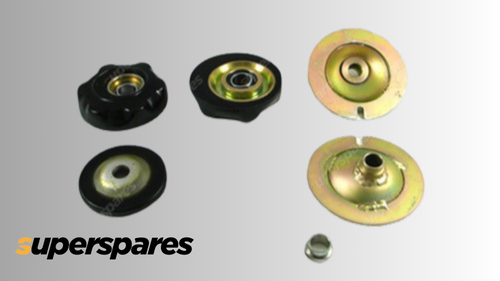Choosing the Right Strut Mount Bushing for Your Vehicle
Author: superspares

Hear that creaking each time you hit a bump? Perhaps you hear it as well whenever you turn your steering wheel while parking? You know what makes that sound? It's none other than a worn-out strut mount bushing, and things are about to turn ugly-if they aren't already-with that particular strut mount if you don't do anything. In case you're wondering, the strut mount is what holds the tip of your shock absorber as well as the upper most coil of your spring. Now, if it weren't for the strut mount bushing, your strut mount would take a lot of beating. So much so that damage would not be limited to the mount but will affect the coil spring and the shock absorber as well. Apart from vibration, the excessive metal-to-metal contact that'll occur without a functional bushing will inflict a great deal of damage to all the parts involved. Think about it. Even if it didn't make any noise, you'd still have to shoulder the cost of replacing the damaged mount, spring and shock absorber. Are you really okay with that considering all that's needed to prevent it is a replacement bushing? Probably not. And here's one more thing. The strut mount bushing helps keep vibrations from damaging the strut bearing assembly, which makes turning the strut possible as you turn the wheel. Once the bearing goes bad, steering will be affected.
If you hear even the slightest clanking or squeaking noise whenever your vehicle bounces, as it rolls over potholes and dips in the road, it's time to check if your strut mount bushing has given up and needs a replacement.
One good thing about selecting a new bushing is that you're not required to make any changes to either your strut mount or any other suspension components. It is designed to match the specifications of most vehicle makes and models. There are, however, a few factors to consider when choosing the right one.
Factors to Consider When Choosing a Strut Mount Bushing
|
 |
Rubber or polyurethane
Most brands boast of durable bushings, ones that are not easily corroded. There is, however, an ongoing debate amongst car owners whether the rubber or polyurethane material is the better choice. Polyurethane, many have observed, is more durable than rubber but makes the car ride slightly hard. Rubber, on the other hand, provides for a smoother ride but wears out more quickly.
How to Replace Your Strut Mount Bushings
Tools that you'll need:
- Two spring compressors (most auto-part shops will loan you these)
- Torx bits
- Wrench
- Jack stands
- A bench-mounted vise
Here are the steps to help you in replacing your strut mount bushing.
Step 1:
Jack up the car and remove the tires. Install the spring compressors securely. Make sure to tighten them down so that the springs move freely.
Step 2:
Use a screwdriver to remove the caps on top of the strut mounts. Loosen the top three nuts on the strut fender wall, but don't remove the bolts just yet. Remove the bracket holding the brake line in place.
Step 3:
Take careful note of how the bolts were inserted; they will need to be put back in place correctly later on. Disconnect the two strut mounting bolts that attach the strut to the wheel spindle mount. Slowly pull the strut away from the mount. Be careful not to drop the wheel spindle mount.
Step 4:
Slide the brake line under the freed strut. Remove the strut from the car by freeing the three nuts at the top of the strut.
Step 5:
Place the torx bit on a bench vise pointing upward. Turn the strut assembly upside down and have it sit on top of this setup. Loosen the first six-sided nut using a wrench. Locate the second four-sided nut and remove it.
Step 6:
You should then see the damaged strut mount bushing. Simply pull this out and replace it with the new one you purchased. Put everything back in reverse order.







